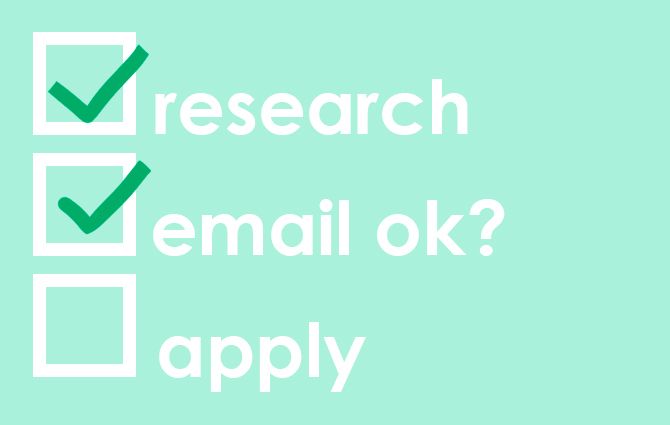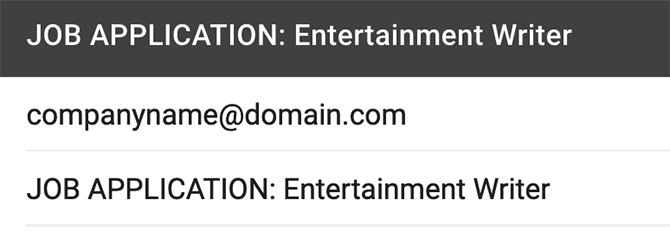Job searching is sort of like hunting for gold. If you play your cards right, you can strike it rich and land a career. If you mess up, you can blow your chances with that company.
The ways in which you can contact the companies you want to work for are multiplying, and one of the methods is through email. Here's how to structure your resume and cover letter for an email application, so you put your best foot forward and don't blow your chances.
1. Do Your Research
The biggest thing you need to do before you even apply is to do your research.
This research applies to the company itself and how they want you to send your application. Some companies don't allow you to apply via email, and if you try that method you'll be automatically rejected.
Once you figure out if you're allowed to email them, follow the instructions on that job posting to the letter. If they have strange requests for the wording in your application, or they tell you to structure your subject line a certain way, do it. If they tell you to address the cover letter to a specific person, do that too.
Those instructions are a test to see if you follow orders properly. They also want to know if you have an eye for detail---both valuable skills in the workplace.
2. Subject Line
The subject line of your email is probably one of the most important parts of your application. It can mean the difference between the company opening the email or thinking it's spam and throwing it out.
If you don't have specific instructions for the subject line, it's best to include a reference to the general purpose of your email.
In this example, something like "JOB APPLICATION: Entertainment Writer" is a good place to start. It's a nice, quick way to clearly state what the content of your email is about. It also a good place for keywords.
In other cases, you'll be sending an email to a shared inbox, but you know who to address the email to. In situations like these, you can add something like "ATTN: [Insert Name]" at the beginning of the subject line. That way anyone who is viewing the inbox will know whom to forward it to.
3. Introductions
When you're introducing yourself and addressing the person who will be reading your application, there are a few things you absolutely need to get right. You need to:
- Spell their name or title correctly.
- Set the appropriate "tone" with your introduction.
Before you apply, research what the company's public "face" looks like. What sort of culture are they trying to put out to the world?
Are they fun-loving and casual? Are they serious? If they're casual, then it's probably okay to go with a simple "hello" and address the hiring manager by their first name---but only if you know their name to begin with.
If the person you're contacting has a specific title they want to be addressed by, use that.
When the company is more serious, you can use "Dear [insert name]" or something similar. It should be noted that titles like "Mr." and "Mrs." has fallen out of style in recent years, as you can't always guess a person's marital status or gender by their online profile.
All of this is to say that when you introduce yourself, you want to make sure your introduction matches the company on a corporate, cultural level. If you don't, it can be a red flag that you may clash with their workplace values.
4. Put Your Cover Letter in the Body of Your Email
When you're sending your application via email, it's best to put your cover letter into the body of the email itself.
This is because when you send an email, that email is your cover letter. It's the first thing the hiring manager will see, so you need to put your best foot forward.
Another reason why you should try this approach: you don't want the hiring manager to read your cover letter twice. Remember that these people are short on time.
If they read a pared down introduction in your email, followed by the full cover letter in an attachment, they may get frustrated. It's a little too much redundancy.
If they request that you attach a copy of your cover letter, however, follow their instructions exactly.
5. If You Attach Anything, Make It a PDF
Some companies do not accept attachments, and if you attach a file to your application it will go straight to junk mail. If a company does not accept attachments, they'll usually let you know in the job posting itself.
If you can't use attachments, or you're worried that your application won't go through with those attachments, make sure you provide links to an online version of your resume, such as your LinkedIn profile. Make sure the anchor text you're using for those links is descriptive enough that people know what they're clicking on.
If you can send attachments, it's usually a safe bet to send those attachments as PDFs. They're a very universal file format that can be opened with a number of different programs and modern browsers too. This makes it easy for people to view your resume whenever and wherever they can.
Worried you might include the wrong information in your attachments? Here's what not to include in your resume.
6. Don't Spam People
Lastly, don't pester people once you've sent off your application. Don't email them asking if they've read it yet. If you do, your correspondence might soon be viewed as spam.
Some companies send out auto-replies to confirm that they've received your application. Others don't.
Sometimes these companies will take a long time to get back to you because the application process is still open. They might not respond at all. This is just the nature of the game.
If the company does email you back to ask you more questions---but doesn't offer an interview---be polite and personable.
If you answer their questions and they don't email you back after several weeks, it's okay to send a quick email asking them if they have any more questions. You can also let them know you're still available for an interview.
However, if the company doesn't respond to this follow-up, or they respond in the negative, don't send them more emails after this. Understand that some online applications simply don't work out. You can always try your hand at another company elsewhere.
Email With Care
Sending a resume via email can be nerve-wracking, but if you follow these basic steps you'll be on the right track. At the very least, you can be assured that your application will be judged on the amount of experience you have---not on some obvious mistake in your application.
Looking for more tips on job searching? Here's a list of common cover letter mistakes.







